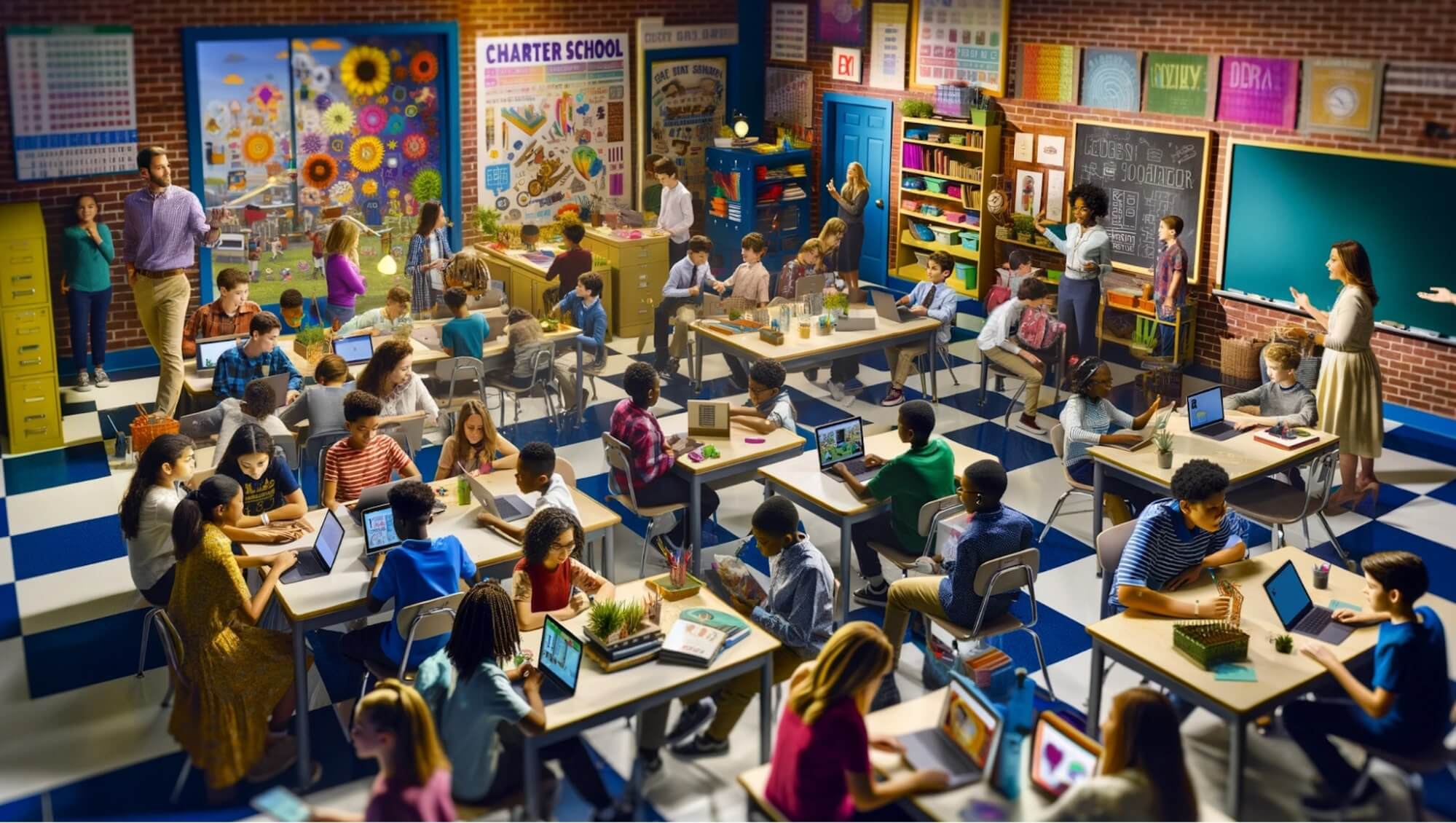
Charter schools and traditional public schools are very similar in a lot of ways but have some very important differences. Traditional public high school does not require students or parents to pay tuition for attendance.
So let's get right down to it.
How Much Do Charter Schools Cost in Ohio?
Charter schools are tuition-free publicly funded schools. Students or parents do not need to pay any money to attend charter schools in Ohio.
Since they're public, charter schools can't make you pay to attend, and they don't have special requirements to get in.
If more kids want to go to a charter school than there are spots available, they use a lottery system to pick students.
The money these schools get for running day-to-day stuff mainly comes from what the state and local area would normally spend per student. But, unlike other schools, charter schools often don't get money for their buildings or to help get things started, so they sometimes need extra support from private money.
As of March 2017, 44 states and Washington D.C. had laws that let these kinds of schools be created and the U.S. government can also give them extra funding through a variety of programs.

If It’s Also Free What Is The Difference?
In Ohio, charter schools represent a unique form of public education, operating independently from traditional public school districts. These innovative schools, which can be established by both nonprofit and for-profit organizations, benefit from public funding to support their operations. One of the key advantages of charter schools is their flexibility, they have the autonomy to tailor their hiring practices and curriculum to meet the specific needs and goals of their students, offering a personalized educational experience. This approach allows charter schools to implement creative and diverse teaching methods and learning environments, creating a better experience for students.
Charter schools are similar to traditional schools in a few common ways. Below are a few critical similarities.
- Non-profit
- Tuition-free
- Non-sectarian
- Open To Anyone Under Age 22
- Non-discriminatory
- Under Same Graduation And Testing Requirements
What is a Charter School
Charter schools often have an alternative learning style which they can do because they are managed and operated under a “charter”. A charter is an agreement between a school board and the sponsor (the group providing the money). Charter schools give students and parents more choices and offer students more creative and tailored approaches to learning.
This means they have the freedom to innovate but they are held to a higher standard than traditional public schools.
Reasons To Choose a Charter School
The current world traditional education system is a one-size-fits-all and not all students fit into that size. There are a few general reasons why students prefer charter schools to traditional high school.
Some of the most common reasons people choose a charter school include:
- Underperforming Traditional School
- Bullying At Previous School
- Alternative Learning Styles
- Family Dynamics
- Medical Condition Affecting Attendance
Because of the heightened accountability required for charter schools, they can often innovate in many ways but some of the most common are:
- Implementing a Unique Mission, Focus or Curriculum
- Lengthening the School Day/School Year
- Selecting, Retaining, & Rewarding Teachers
- Special Use of Technology
Career Prep Credit Recovery Innovation
Since Career Prep High School is a charter school, we have the ability to innovate and change our approach to better fit our students' needs.
Career Prep High School is specifically designed to suit students who have struggled with traditional high school for a variety of reasons. Career Prep is unique because we enable students to complete the required coursework that fits within their schedule.
Many students cannot complete high school in the traditional way for many reasons. We are ideal for students who have struggled with traditional high school for a variety of reasons. Some of the most common challenges that our students face include:
- Students who are required to work during the day
- Students who have to care for children
- Students who don’t have any reliable transportation to get to school
- Students who don’t have a stable home environment
- Students who have failed classes and need to make up credits
Career Prep allows students to take classes on the days and times that better accommodate a student's complicated and busy life.
Our world-class educators and staff are committed to giving students every support and resource required to succeed and complete their high school education whether that means providing them 1:1 tutoring or helping them find a ride to get to school on time.
We know that completing high school will drastically improve a student's life for the better and will yield a positive return for the rest of their life.

Non-Tuition Costs For Charter Schools
Ohio charter schools do not charge tuition for enrollment, making them accessible to a wide range of students, regardless of their financial status. Although tuition is not part of the charter school model in Ohio, there may still be nominal fees for specific courses, activities, or programs. However, this is similar to what you would find in traditional public schools.
These fees are typically minimal and are in place to cover costs that are not funded by the state or federal government. The specific amount can vary between charter schools and based on the specific scenario. These additional fees are not typically associated with the fundamental offerings of the charter school but often some additional programs outside of the in-classroom educational environment.
While there is a lack of tuition fees for charter school there can be other costs associated. Some of these costs might include
- Uniforms or dress code requirements (Career Prep Schools do not require uniforms)
- School supplies for specialized courses
- Extracurricular Activities
- Transportation
Uniforms are more commonly expected from charter schools than in traditional schools. This is meant to create a sense of unity and discipline among students. Costs of uniforms can vary and some groups may offer assistance or have a second-hand uniform exchange program, it is an out-of-pocket expense for many families.
In some instances where there might be specialized courses that are outside of the normal curriculum, these can sometimes require additional costs for basic supplies to be able to complete the course but these are case by case.
Extracurricular activities like sports, arts, and clubs, may also require fees for participation to be able to afford equipment or trips.
Transportation is a significant consideration in education. Traditional public schools often provide their own bus systems, which cover widespread areas to ensure students arrive at class on time. In Ohio, charter schools are also legally permitted to use these bus systems, although this can sometimes lead to complications in certain areas. Career Prep Schools prioritize ensuring all students have reliable transportation to class. As part of our mission to support students' success comprehensively, we seek to find reliable transportation solutions based on the students' needs. This might include facilitating the use of public transportation or even arranging for students to be picked up.
Transportation is a big deal when it comes to getting to school every day. Most regular public schools have their own buses that pick up students from all over the place, making sure they get to school on time. Charter schools like Career Prep School work a bit differently. Even though charter schools can technically use the public school buses, we've found that in Ohio, it's not that simple for us. It might be because we don't have as many students as the big public schools, or maybe there's another reason we're not sure about. But, what's important is that Career Prep School is all about finding solutions. So, we're always looking for ways to help our students get to school easily and safely, even if we can't use the regular school bus system.
Comparing Costs: Charter Schools vs. Public Schools
The way each type of school is funded is important to understand. Charter schools are funded from the state based on a per-student basis. This money is intended to cover all operational costs like salaries, keeping the lights on and resources needed to do the teaching.
Traditional public schools receive funding from a combination of state funding, local property taxes, and at times federal funds. This can often lead to a larger per-student rate. This does not always translate to better quality in education. Factors like how well the funds are used, administrative costs, and using the funds towards directly educational services or resources can impact the overall quality of the education with traditional public schools.
Conclusion
Ohio's charter schools present a valuable alternative to traditional public education, providing a tuition-free learning environment that caters to a diverse array of student needs and preferences. These schools distinguish themselves through their innovative teaching methods and flexible curriculums, designed to address the unique challenges and aspirations of each student.